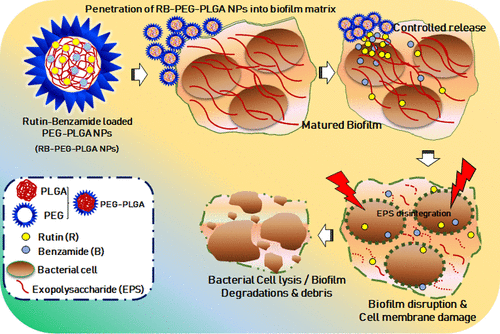当前位置:
X-MOL 学术
›
ACS Appl. Bio Mater.
›
论文详情
Our official English website, www.x-mol.net, welcomes your
feedback! (Note: you will need to create a separate account there.)
Co-delivery of Diverse Therapeutic Compounds Using PEG–PLGA Nanoparticle Cargo against Drug-Resistant Bacteria: An Improved Anti-biofilm Strategy
ACS Applied Bio Materials ( IF 4.6 ) Pub Date : 2020-01-07 , DOI: 10.1021/acsabm.9b00850 Murugesan Sathiya Deepika 1 , Ramar Thangam 2 , Shenbagamoorthy Sundarraj 3 , Thankaraj Salammal Sheena 4 , Srinivasan Sivasubramanian 5 , Jeganathan Kulandaivel 4 , Ramasamy Thirumurugan 1
ACS Applied Bio Materials ( IF 4.6 ) Pub Date : 2020-01-07 , DOI: 10.1021/acsabm.9b00850 Murugesan Sathiya Deepika 1 , Ramar Thangam 2 , Shenbagamoorthy Sundarraj 3 , Thankaraj Salammal Sheena 4 , Srinivasan Sivasubramanian 5 , Jeganathan Kulandaivel 4 , Ramasamy Thirumurugan 1
Affiliation

|
Controlling biofilms of bacteria is a challenging aspect because of their drug-resistance potentials against a range of antibiotics, demanding the development of active anti-biofilm agents. Rutin (R), a natural antioxidant, and benzamide (B), a synthetic antibacterial agent, have several pharmacological and antibacterial abilities. Herein, we developed PEG–PLGA NPs that synergistically carried rutin and benzamide as drug candidates, while displaying therapeutic and anti-biofilm functions. These drug delivery NPs were synthesized by the oil-in-water emulsion (O/W) solvent evaporation technique. The obtained NPs were characterized by UV–vis, FT-IR, SEM, TEM, and DLS measurements. Confocal laser scanning microscopy was employed to evaluate the anti-biofilm capabilities against Staphylococcus aureus and Pseudomonas aeruginosa and further quantified the levels of residual biofilm constituents such as protein and exopolysaccharide (EPS). Drug release experiments showed the controlled release of rutin–benzamide (RB) for several days. Antibacterial analyses showed that the minimum inhibitory concentration (MIC) of NPs was at least two times lower than that of the free drugs. RB–PEG-PLGA NPs revealed that they targeted biofilm-forming bacteria through the disruption of the membrane and biofilm surface and were observed to be nontoxic when tested using human erythrocytes and human cell lines. In vivo evaluations in zebrafish showed that the NPs did not alter the antioxidant functions and histological features of tissues. On the basis of results obtained, it is substantiated that the rutin–benzamide-loaded nanocarrier offers potential anti-biofilm therapy due to its high anti-biofilm activity and biocompatibility.
中文翻译:

使用 PEG-PLGA 纳米颗粒货物共同递送多种治疗性化合物以对抗耐药细菌:一种改进的抗生物膜策略
控制细菌的生物膜是一个具有挑战性的方面,因为它们对一系列抗生素具有耐药性,需要开发活性抗生物膜剂。芦丁 (R) 是一种天然抗氧化剂,苯甲酰胺 (B) 是一种合成抗菌剂,具有多种药理和抗菌能力。在这里,我们开发了 PEG-PLGA NPs,它们协同携带芦丁和苯甲酰胺作为候选药物,同时显示出治疗和抗生物膜功能。这些药物递送纳米颗粒是通过水包油乳液 (O/W) 溶剂蒸发技术合成的。获得的纳米颗粒通过紫外-可见、FT-IR、SEM、TEM 和 DLS 测量进行表征。共聚焦激光扫描显微镜用于评估对金黄色葡萄球菌的抗生物膜能力和铜绿假单胞菌并进一步量化了残留生物膜成分的水平,例如蛋白质和胞外多糖(EPS)。药物释放实验表明,芦丁-苯甲酰胺 (RB) 可以控制释放数天。抗菌分析表明,NPs 的最低抑菌浓度 (MIC) 至少比游离药物低两倍。RB-PEG-PLGA NPs 揭示了它们通过破坏膜和生物膜表面来靶向形成生物膜的细菌,并且在使用人类红细胞和人类细胞系进行测试时观察到它们是无毒的。斑马鱼的体内评估表明,NPs 不会改变组织的抗氧化功能和组织学特征。根据获得的结果,
更新日期:2020-01-07
中文翻译:

使用 PEG-PLGA 纳米颗粒货物共同递送多种治疗性化合物以对抗耐药细菌:一种改进的抗生物膜策略
控制细菌的生物膜是一个具有挑战性的方面,因为它们对一系列抗生素具有耐药性,需要开发活性抗生物膜剂。芦丁 (R) 是一种天然抗氧化剂,苯甲酰胺 (B) 是一种合成抗菌剂,具有多种药理和抗菌能力。在这里,我们开发了 PEG-PLGA NPs,它们协同携带芦丁和苯甲酰胺作为候选药物,同时显示出治疗和抗生物膜功能。这些药物递送纳米颗粒是通过水包油乳液 (O/W) 溶剂蒸发技术合成的。获得的纳米颗粒通过紫外-可见、FT-IR、SEM、TEM 和 DLS 测量进行表征。共聚焦激光扫描显微镜用于评估对金黄色葡萄球菌的抗生物膜能力和铜绿假单胞菌并进一步量化了残留生物膜成分的水平,例如蛋白质和胞外多糖(EPS)。药物释放实验表明,芦丁-苯甲酰胺 (RB) 可以控制释放数天。抗菌分析表明,NPs 的最低抑菌浓度 (MIC) 至少比游离药物低两倍。RB-PEG-PLGA NPs 揭示了它们通过破坏膜和生物膜表面来靶向形成生物膜的细菌,并且在使用人类红细胞和人类细胞系进行测试时观察到它们是无毒的。斑马鱼的体内评估表明,NPs 不会改变组织的抗氧化功能和组织学特征。根据获得的结果,











































 京公网安备 11010802027423号
京公网安备 11010802027423号